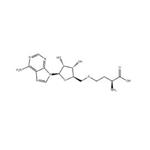S-Adenosyl-L-homocysteine (SAH) is an amino acid derivative and an intermediate, by-product, or modulator of several metabolic pathways, including the activated methyl cycle and cysteine biosynthesis. It is also a product of S-adenosyl-methionine (SAM)-dependent methylation of biological molecules, including DNA, RNA, and histones and other proteins. SAH is a risk factor for many diseases, including cancer and neurodegenerative diseases. In addition, inhibitors that block its hydrolysis are being developed as anti-viral, anti-parasitic, anti-arthritic and immunosuppressive agents.
A novel biomarker for predicting susceptibility of a subject to a mental or neurodegenerative disorder.
SAH is suitable for use:
- to investigate whether AdoHcy competes with AdoMet in the down-regulation of reporter activity of LUC reporter gene
- as a reagent to study the abundance patterns of SAH and its correlation with vertebrate metamorphosis
- in the optimization of the protein (lysine K) methyltransferase SET7/9 activity assay
- in the fluorescence polarization (FP) assay during dengue virus methyltransferase activity measurement
- as a standard for the measurement of SAH from blood samples by high performance liquid chromatography (HPLC) with fluorimetric detection method
ChEBI: The S-adenosyl derivative of L-homocysteine.
S-(5′-Adenosyl)-L-homocysteine (AdoHcy/SAH) is a component of intracellular homocysteine stress. AdoHcy is a competitive inhibitor (versus AdoMet) of DNA methyltransferases (S-adenosyl-L-methionine (AdoMet)-dependent methyltransferases) involved in epigenetics. Consequently, AdoHcy is used in a variety of studies on epigenetics in hyperhomocysteinemic states. AdoHcy is metabolized by S-adenosylhomocysteine hydrolase (AHCY). AdoHcy is the product of enzymatic transmethylation reactions involving S-Adenosylmethionine (SAM). It is reconverted to SAM by its cleavage into adenosine and L-homocysteine, a substrate of thetin-homocysteine S-methyltransferase. The concentration alterations of SAM and SAH in plasma serve as predictors of cellular methylation potential and metabolic alterations. Methylation capacity indicates specific genetic polymorphisms and/or nutritional deficiencies. Methylation is important in epigenetics, reprogramming, and cancer.
It has been recrystallised several times from aqueous EtOH or H2O to give small prisms and has max 260nm in H2O. The picrate has m 170o(dec) from H2O. [Baddiley & Jameison J Chem Soc 1085 1955, de la Haba & Cantoni J Biol Chem 234 603 1959, Borchardt et al. J Org Chem 41 565 1976, NMR: Follmann et al. Eur J Biochem 47 187 1974, Beilstein 26 III/IV 3676.]



